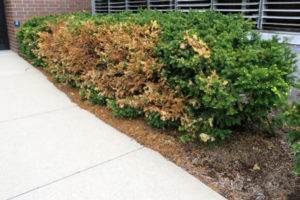 Cold temperatures, chilling winds, snow, and ice can be extremely hard on your landscape. In the past, you may have been led to believe that it is the freezing cold that will damage your trees, shrubs, and grasses. However, it is actually the fluctuation in temperatures– from cold to slightly warmer and back to freezing again– that causes the most harm. On top of the weekly weather changes, late season pruning, inadequate watering in the fall, and some hungry critters will leave your landscape needing a whole lot of TLC.
Cold temperatures, chilling winds, snow, and ice can be extremely hard on your landscape. In the past, you may have been led to believe that it is the freezing cold that will damage your trees, shrubs, and grasses. However, it is actually the fluctuation in temperatures– from cold to slightly warmer and back to freezing again– that causes the most harm. On top of the weekly weather changes, late season pruning, inadequate watering in the fall, and some hungry critters will leave your landscape needing a whole lot of TLC.
Winter’s Impact On Trees
Broken Limbs
Between heavy snow, ice, and wind, your trees’ branches take the brunt of the harsh weather conditions. When branches break, they are left dangling and looking terrible. Not to mention, they are a safety hazard and could come crashing down at any moment.
Damage From Rodents And Other Animals
Mice, voles, deer, rabbits and other creatures often spend their winters nibbling through your landscape which can result in significant damage. These critters snack on vulnerable twigs, bark, and even foliage. In some instances, they even completely remove the bark around the base of the tree which will kill it. The damage is typically irreversible but if it is not too extensive, the tree might be able to seal its own wounds.
Frostburn On Evergreens
If the needles on your evergreens are looking brown or scorched, it could be because of a frostbite. Narrow-leaved evergreens, including hemlock, pine, juniper, and yew, as well as broad-leaved evergreens including rhododendron and boxwoods are often more susceptible to winter burn, also referred to as desiccation. Between the winter sun and winds, you may be left with a bare evergreen. Water that was stored in the stems and roots freeze, keeping them from replenishing what was lost. Many leaves fall to the ground and are pushed away by new growth. If your tree still has leaves, you can hand strip or prune them in an effort to protect them.
Frost Cracks In Trunk
If you have ever noticed long cracks in the trunks of your trees, they are likely the result of frost cracks. These occur during periods of cold winter nights followed by warmer days when the sun is shining bright. Some are even several feet long and inches wide and happen between alternating temperatures. However, these are not much to worry about as trees make an effort to heal themselves by forming a callus along the crack.
Shrubs
First Frost Of The Fall… As you look at your shrubs, do you spy new foliage that is brown or black? New growth from the end of summer and early fall pruning could have been hit by the first frost of the season. Leaves and flowers that were damaged by the frost may fall off on their own. You could also prune the severely damaged or broken branches in an effort to stimulate new growth. The majority of plants will grow new leaves if the branches and buds were not injured too badly.
Salty Side Effects
While salt is beneficial when it comes to ice removal from the sidewalks and driveways, it can really hurt your landscape. Road runoff contains dissolved salts that will not only damage your plants but will also alter the structure of the soil. This causes the soil to become compacted meaning that water, nutrients, and oxygen are unable to reach your plants which puts them under stress. If you have seen dried, burnt edges on your leaves, it is probably the result of salt damage. Solution? Flush the area around your vegetation at the beginning of spring by using a hose to put 2 inches of water on them for 2-3 hours. Repeat this process in three days. This will help remove the salt from the soil.
Winter’s Impact On Your Lawn
Frost Heaving
Take time to walk around your lawn to check your ornamental grasses and other plants. Look for exposed roots or plants that have heaved from the ground. What causes frost heaving? Repeated periods of soil freezing and thawing push plants out of the ground and exposes their roots. If you see a plant that has heaved from the ground, replant it when the soil thaws to keep it from dying.
Take Time For Preventative Care Next Year
As you become aware of the kind of winter damage that affects your lawn and landscape, you can take the necessary steps to keep it from happening again next year.
Here are a few tips that might be helpful for you…
- Do not prune late in the summer. Pruning stimulates new growth that might be frost zapped by snow and ice.
- Continue watering trees and shrubs, especially evergreens, until the ground freezes.
- Mulch acts to conserve soil moisture and insulate the roots from freezing temperatures.
- Use burlap screens to protect evergreens from the wind and salt spray.
- Invest in screen wire or hardware cloth to wrap your trees’ trunks and lower branches of young trees. Wrap should be below the ground line to high enough above the possible snow line to keep critters and rodents from reaching the branches and trunk.
Contact us (859-292‐8556) today for a free consultation!

About First Green Commercial Landscaping
First Green Commercial Landscaping is a locally owned leading provider of lawn care and landscaping services in the Cincinnati / Northern Kentucky area. We provide superior customer service and strive to build long term business relationships with our clients.
- Lawn Care
- Landscape Maintenance
- Snow Removal
>> Learn More
